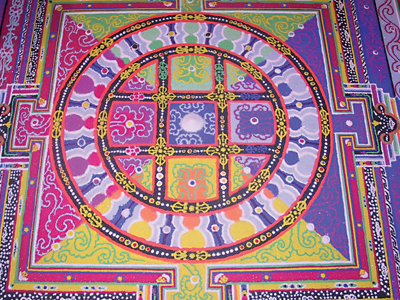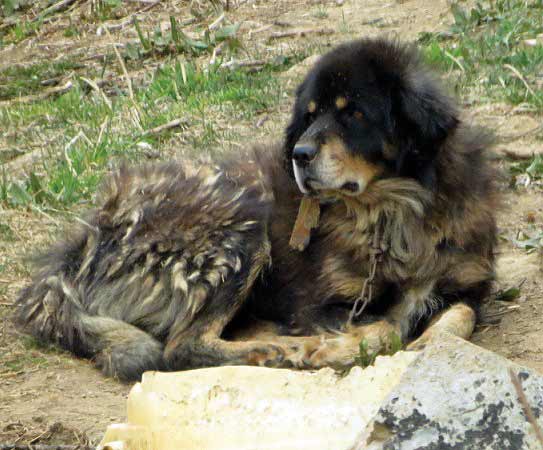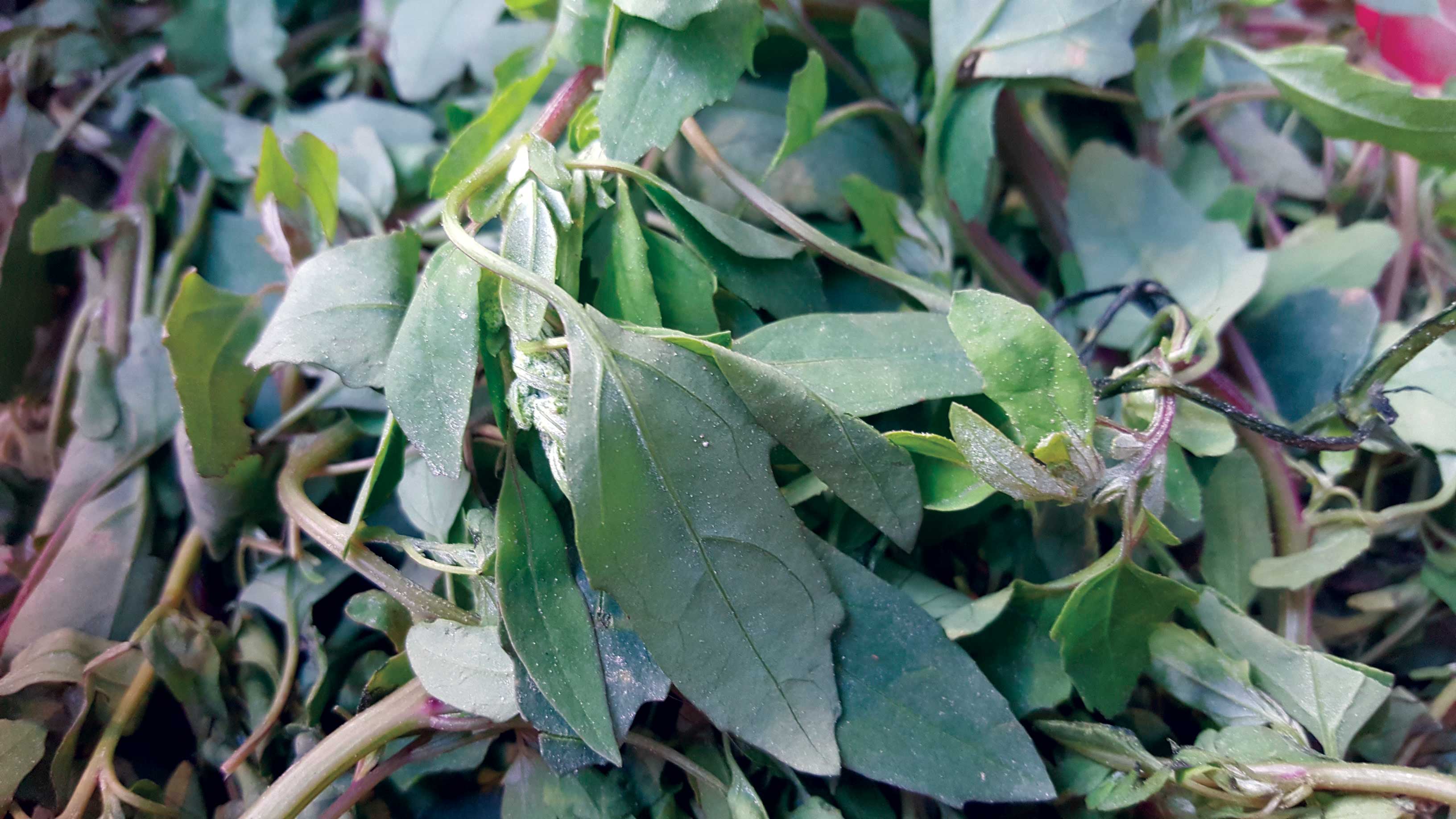The Kuenrig Kiylkhor is the celestial palace of an enlightened being – the proverbial castle in the sky! It has rooms, walls, doors, a garden and even its own security guards. It is also an image popularly depicted in a mandala form on Buddhist thankas, murals and on occasions, in sand.
 One such occasion occurred recently in Kathmandu, when young student monks from the Tsechen Shedrub-Ling Mon Gon Lobdra (Great Compassion Monastic School) Lo Manthang Mustang, constructed and then destroyed a sand mandala depicting the Kuenrig Kiylkhor.
One such occasion occurred recently in Kathmandu, when young student monks from the Tsechen Shedrub-Ling Mon Gon Lobdra (Great Compassion Monastic School) Lo Manthang Mustang, constructed and then destroyed a sand mandala depicting the Kuenrig Kiylkhor.
According to belief, a celestial king whose son Norbu Drimed had recently died, first constructed the Kuenrig Kiylkhor Mandala. When the king inquired of Lord Buddha where his son was, the Buddha told him his son was in hell and if he wanted him to be raised to heaven, the king should construct a mandala of a certain design called Kuenrig Kiylkhor.
Lord Buddha also passed the mandala design to Chak-na Dorjee, also known as Vajra Vidaya, a king from the East Indian province of Himachal Pradesh. He taught the Lama Rapsel Dawa, who in turn taught his disciples and eventually it reached the monks of Sakya Tinzin, who brought it to Upper Mustang. Today, in the 15th Century Champa Gompa in Lo Manthang, a wall mural depicts the same mandala design.
Kuenrig Kiylkhor means heavenly abode and its design depicts the celestial home of Vairochana Buddha, an enlightened being, and Gyalwa-Rig-Ngn, the five other deities who live with and protect him.
The center square of the mandala illustrates the home of the Buddha surrounded by four pillars. The color of the center is white and represents the Buddha and the celestial ether. From here, each color represents a different direction, one of the four other elements, and a different deity. East (blue) is for Aksobhya and water, west (red) is for Amitabha and fire, south (yellow) is for Ratnasambhava and earth, and north (green) is for Amoghasiddi and air.
Moving out from the center there are depictions of the walls of the palace, where the other minor deities live. Beyond the four gates, guarded by fierce doorkeepers and decorated with Dharma Wheels and depictions of the deer representing Lord Buddha’s first sermon audience, lies the garden surrounded by an outer wall of fire and protecting deities.
Normally the construction of this mandala would take five to seven days, but with permission from the Khempo of Mustang, up to eight students worked for some 25 hours over a three-day period to complete it for the exhibition.
After a short ritual in which the Khempo prepared the elements and purified the area, two student monks using only a piece of string run through a cloth bag of blue chalk powder, laid out a geometric grid on the marble floor of the function room at the Ambassador Hotel. The intricate square within square, crosshatched grid was then used to draw the outline of the mandala using another piece of string dipped in a red dye. To create the circles and arches in the design, the monks used a simple device: a led pencil with a piece of string tied to it. The other end of the string was anchored to a point on the grid with a finger and using a pendulum like motion, the curves were drawn. The acid test came when the outer circle was drawn. The four corners of the largest square had to touch the circle’s circumference exactly – and they did! Not a small feat without the use of even a ruler.
After another blessing from the Khempo, a pair of monks began filling in the design using a sand of crushed marble, dyed with colors. As the mandala grew, and space permitted, another two monks joined in the work, then another pair and finally eight young monks aged between 16 and 18 years old were working on the construction.
For some of the less intricate areas of the design, the monks allowed the sand to flow through their fingers from a closed fist. When detail was called for they used a tapered copper tube. The sand went in the larger end and by running a wooden stick up and down serrations on the tube, the sand was vibrated, a few grains at a time, out of a hole at the base of the tube.
Having trained for three years, the monks’ skills were finely honed, but still their concentration was intense. Remembering the design by understanding the story and meanings behind the shapes and colors, the monks were able to work with only an occasional reference to a manual, written in Tibetan script, kept at hand by the school’s head monk.
After two and a half days of dedicated work, six of the monks allowed the initial pair to complete the final touches while they joined the Khempo in the final prayers and chants of the mandala ritual.
For four hours, the monks prayed over the mandala, calling on each of the deities housed within to bring physical health and mental well being to those who took part in its construction and those who viewed it.
Finally, in keeping with the Buddhist tenet of impermanence, 55 hours after the first prayer was said, and in front of a crowd that included three ambassadors, members of the diplomatic, expatriate and business communities, local artists, international volunteers and the general public, a small brass Dorjee (vajra) was drawn along the four axis of the mandala, breaking through the sand walls, the garden and the rooms into the centre abode of the enlightened one. Then, from the outside in, the two monks, using a cloth and small brush swept the sacred sand into a copper urn, later to be emptied into a river. The sand will then travel to the sea and be dispersed around the world, taking with it its karma.
The students of the Tsechen Shedrub-Ling Mon Gon Lobdra (Great Compassion Monastic School) Lo Manthang Mustang, are currently in Kathmandu attending their winter session. Each year they rent a large house in either Swayambunath or Boudhanath for the five months when it is too cold to study in Lo Manthang. The school is a non-profit, monastic school funded through a few individual scholarships and by a grant from the American Himalayan Foundation. The idea of the exhibition was to raise awareness of the unique cultural and religious heritage of the Upper Mustang region and to raise funds for the construction of a permanent monastery here in Kathmandu to accommodate the monks and students each winter.
For information on contributions to the school or sponsorship of one of the students, you can contact the American Himalayan Foundation in Kathmandu on 410089.
(Bruce Moore is the Director of an INGO in Nepal).









